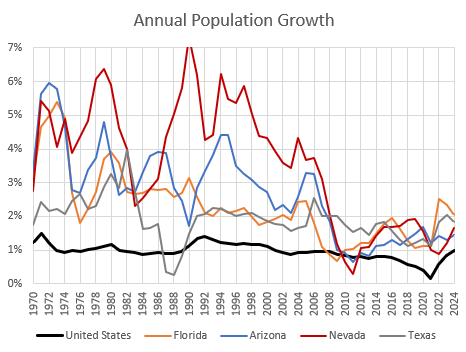The New Business Cycle: Part 4
Migration and the Cycle
Series Table of Contents:
Review of 2008 vs Today (free post from 2024)
Part 4: Migration and the Cycle
In the 20th century, production activity in housing was a dependable leading recessionary indicator, and likely a causal factor moving into and out of recessions. In this century, a permanent shortage of housing has changed cyclical patterns. Before 2008, housing was regionally in short supply in the Closed Access cities (NYC, LA, Boston, San Francisco/San Jose, San Diego). So, the expansion was associated with increased migration out of those cities, and a building boom for those displaced families in the cities they moved to. The mortgage crackdown in 2008 put every city into shortage conditions. The cyclical displacement out of the Closed Access cities continues, but now other large cities aren’t able to greet them with a proportional increase in new housing. Now, the factors moderating the flow of migrants out of the Closed Access cities aren’t just a balance of rising rents against the stresses of displacement. Now, they reflect a balance of rising rents against the stresses of displacement and the relative level of inflated rents in the possible destinations.
So, most of the previous destinations for Closed Access refugees have been growing more slowly since 2008 even though American population growth didn’t really start to slow down considerably until the first Trump presidency.
Texas has been the growth story since 2008, but, as Figure 1 shows, that is really a product of all the fastest growing states slowing down to the rate of growth that Texas was at before.
(Digression: Also, I can’t help pointing out Nevada in this chart. Of course you’ve heard it here before, but all those spec homes they built in the desert where they weren’t wanted were a mass hallucination. It didn’t happen. Nevada had been the fastest growing state for most of the past 40 years, and outside of the recession of the early 1980s, it had never grown as slowly as it did during the subprime boom.)
For the first decade of the housing bust, migration out of the Closed Access cities slowed as Americans retrenched after we briefly had become poor enough to match our poor housing supply. In the second decade, the outflows from the Closed Access cities have returned, but now they are more dispersed because supply has been inelastic everywhere, so rent inflation across the country affect location preferences in directing migration flows.
Keep reading with a 7-day free trial
Subscribe to Erdmann Housing Tracker to keep reading this post and get 7 days of free access to the full post archives.


